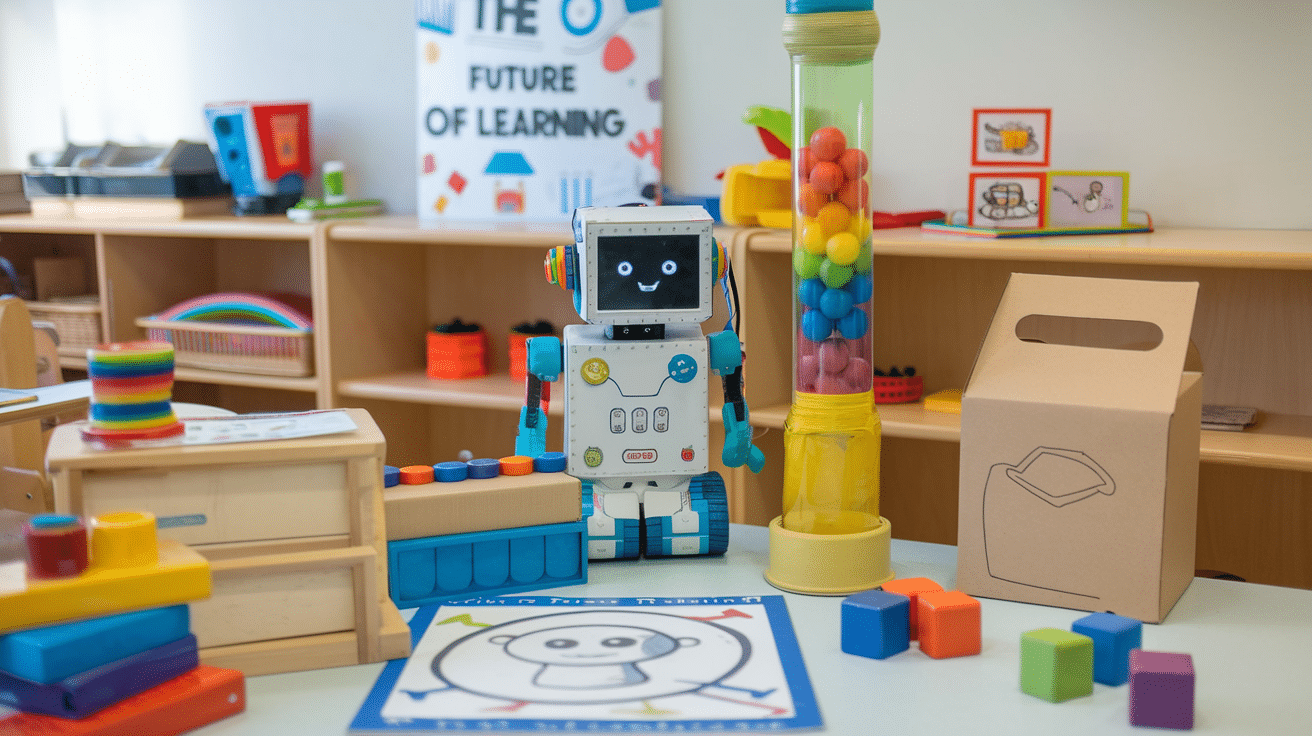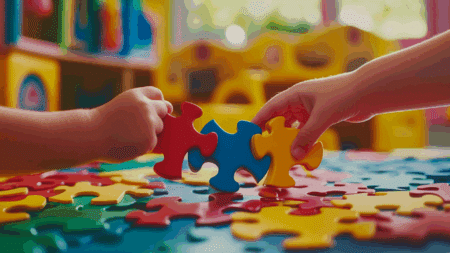Want to know why early STEM learning matters for kids? Many parents wonder, too.
STEM skills help children learn to think, solve problems, and work with others from an early age. But some folks worry that science and math might be too hard for little ones. They’re not!
Young kids are curious by nature, and they ask questions about everything around them.
This natural wonder makes preschool the perfect time to start STEM learning.
In this blog, we will find some simple ways to incorporate science, technology, engineering, and math into your child’s daily activities. These basics will help them grow into confident learners who aren’t afraid to try new things.
Is Preschool STEM the New Future of Learning?

Parents and educators now recognize that STEM education begins long before formal schooling. Children start to form basic concepts about science, technology, engineering, and mathematics during their earliest years.
Their brains develop quickly during this time, making it ideal for building STEM foundations.
Research shows that children who engage with STEM concepts early often perform better in school later. They develop critical thinking skills that help them in all subjects, not just science and math.
Many preschools now include STEM activities that feel like play but teach important concepts:
- Block building helps children understand basic physics and spatial thinking
- Sorting activities introduce mathematical concepts like patterns and sets
- Simple experiments with water or light spark scientific inquiry
- Counting games build number sense naturally
- Early childhood experts note that these activities work best when adults ask open-ended questions rather than providing answers. This approach encourages children to think for themselves.
The goal isn’t to create tiny scientists but to nurture the natural curiosity that all children possess when young learners feel comfortable asking “why” and “how,” they build confidence that carries into future learning experiences.
This early comfort with STEM topics makes formal education less intimidating later on.
Hands-On Preschool STEM Activities
STEM learning doesn’t have to wait until middle school; it can (and should!) begin in the preschool years. These hands-on activities are designed to spark curiosity, build foundational skills, and make learning feel like play.
From engineering simple machines to experimenting with patterns and motion, each idea encourages determination through doing. Are you ready to bring science, tech, engineering, and math to life for little learners?
Let’s plunge into 33 creative, age-appropriate STEM activities you can start today.
1. Rainbow Walking Water Experiment

This colorful science activity shows children how water can “walk” between containers using paper towels. Kids will watch with wonder as the colored water moves up the paper towel and down into the next cup, mixing colors along the way. This simple experiment helps explain capillary action and color mixing in a visual way that preschoolers can grasp and enjoy.
- Materials Needed: Clear cups, water, food coloring, paper towels
- Skills Developed: Color recognition, observation skills, basic physics concepts, prediction
- Time Required: 15 minutes setup, several hours for full effect
2. Baking Soda and Vinegar Volcano

A classic science activity that never fails to impress young children. When baking soda (a base) is mixed with vinegar (an acid), they create a chemical reaction that produces carbon dioxide gas. The resulting “eruption” helps children learn about reactions in an exciting, hands-on way that they can see, hear, and feel.
- Materials Needed: Baking soda, vinegar, dish soap, food coloring, container
- Skills Developed: Cause and effect, chemical reactions, observation
- Safety Note: Adult supervision is required
3. Sink or Float with Household Items

This simple but effective science experiment lets children test and categorize different objects that sink or float in water. Children can make predictions, test their theories, and learn basic physics concepts related to density, buoyancy, and the properties of materials.
- Materials Needed: Container of water, various household objects
- Skills Developed: Prediction, classification, critical thinking, observation
- Extension Idea: Chart results on a simple graph
4. Color Mixing with Ice Cubes

Freeze water colored with food coloring in ice cube trays. Children can place different colored ice cubes together on paper towels or in a container and observe how colors mix as the ice melts. This activity combines color theory with learning about states of matter as children watch solids turn to liquids.
- Materials Needed: Ice cube trays, food coloring, water, paper towels
- Skills Developed: Color theory, states of matter, observation, patience
- Prep Time: Needs freezing time beforehand
5. Growing Beans in a Bag

Children can observe the entire germination process when beans are grown in clear plastic bags against a window. This window garden lets kids see roots forming and plants growing without soil. The daily changes provide great opportunities for observation, measurement, and discussion about what plants need to succeed.
- Materials Needed: Lima beans, plastic bags, paper towels, water
- Skills Developed: Plant biology, observation, documentation, patience
- Duration: 7-10 days for full growth cycle
6. DIY Mini Greenhouse

Create tiny greenhouses using clear plastic containers or cups and watch seeds sprout. Children learn about plant growth cycles, the effect of sunlight, and the concept of greenhouse warming. This activity allows for ongoing care and observation as plants develop from seeds into seedlings.
- Materials Needed: Clear plastic containers, soil, seeds, spray bottle
- Skills Developed: Plant life cycles, responsibility, observation
- Maintenance: Requires regular watering and care
7. Fizzy Color Mixing

When colored baking soda meets colored vinegar, children witness both a chemical reaction and color mixing simultaneously. The fizzing action charms young learners while teaching multiple science concepts at once. Children can use droppers to control the vinegar, adding fine motor practice to this multi-sensory experiment.
- Materials Needed: Baking soda, vinegar, food coloring, tray, and droppers
- Skills Developed: Color mixing, chemical reactions, cause and effect, fine motor skills
- Cleanup Level: Medium (can be messy)
8. Magnetic vs. Non-Magnetic Sorting

Children test various objects around the classroom to see if they stick to magnets, then sort them into magnetic and non-magnetic groups. This activity introduces the properties of materials, helps children develop prediction skills and classification abilities, and teaches them that not all metals are magnetic.
- Materials Needed: Strong magnets, collection of various materials
- Skills Developed: Classification, properties of materials, prediction
- Safety Note: Use large magnets that cannot be swallowed
9. Exploding Lunch Bag Experiment

This dramatic demonstration combines baking soda and vinegar inside a sealed plastic bag. As gas builds up inside, the bag eventually pops with a satisfying bang. This safe “explosion” helps children visualize how gases take up space and create pressure in a confined area.
- Materials Needed: Ziplock bag, baking soda, vinegar, tissue
- Skills Developed: Chemical reactions, gas production, cause and effect
- Safety Note: Do it outside or in an easy-to-clean area
10. DIY Rain Cloud in a Jar

Create a model rain cloud using shaving cream and colored water. As the colored water is dropped onto the “cloud,” it eventually becomes heavy enough to fall through as rain. This visual demonstration helps children tangibly understand precipitation they can observe up close.
- Materials Needed: Clear jar, shaving cream, food coloring, and droppers
- Skills Developed: Weather concepts, water cycle understanding, observation
- Prep Time: 5 minutes
11. Coding with Arrows (Directional Play on the Floor)

Create a simple grid on the floor using tape and have children follow directional arrows to reach a destination. This unplugged coding activity teaches the basics of algorithms and programming without any screens or devices. Children learn to follow sequential instructions and understand directional concepts.
- Materials Needed: Masking tape, arrow cards, floor space
- Skills Developed: Sequential thinking, direction following, early coding concepts
- Group Size: Works well with 1-6 children
12. DIY Light Table with Plastic Containers

A homemade light table made from a clear plastic container and string lights allows children to find out transparency, color mixing, and light properties. They can place colored transparent items on top and observe how light passes through different materials and colors.
- Materials Needed: Clear plastic container, battery-operated lights, translucent items
- Skills Developed: Color theory, light properties, visual discrimination
- Safety Note: Use battery lights only, not electric
13. Build a Robot from Recyclables

Children design and create robots using cardboard boxes, paper tubes, bottle caps, and other recyclable materials. This open-ended engineering activity encourages creativity while teaching about repurposing materials. Kids practice planning, constructing, and problem-solving as they build their unique robots.
- Materials Needed: Various recyclable materials, tape, glue, and decorative items
- Skills Developed: Engineering design, creativity, fine motor skills, spatial awareness
- Duration: 30-60 minutes
14. Simple Pulley System

A basic pulley made with a spool and string demonstrates how simple machines make work easier. Children can experiment with lifting objects using the pulley versus lifting them directly. This hands-on experience with physics concepts helps children understand mechanical advantage concretely.
- Materials Needed: String, spools or pulleys, hooks, small buckets or containers
- Skills Developed: Simple machines, physics, cause and effect
- Setup Time: 10-15 minutes with adult help
15. QR Code Scavenger Hunt

Place QR codes around the room that link to pictures, audio clues, or simple questions. Children scan the codes with a tablet to find the next location. This technology-based hunt introduces digital tools while incorporating movement and problem-solving into a fun, active learning experience.
- Materials Needed: Tablet or device, printed QR codes, prizes or clues
- Skills Developed: Technology use, problem-solving, following directions
- Prep Work: High (requires creating and placing QR codes)
Other Preschool STEM Activities Beneficial During Developmental Stage
Looking for more ways to bring science, technology, engineering, and math into your preschooler’s day?
Beyond the hands-on activities we’ve shared, there are many resources to support early STEM learning. Books, toys, games, and even everyday routines can become opportunities for young minds to explore STEM concepts.
These options work well alongside the activities we’ve already covered and help build a strong foundation for future learning.
16. Tech-Free Morse Code Message Activity
Children learn to communicate using dots and dashes, creating and decoding simple messages without technology.
This activity introduces the concept that information can be coded and decoded in different ways. Children practice pattern recognition and learn about historical communication methods.
17. Finding Simple Machines Using Toy Gears and Pulleys
Commercial or homemade gear sets allow children to see how motion transfers from one gear to another.
As children connect and manipulate the gears, they learn about the direction of rotation, speed, and how mechanical systems work together.
This hands-on engineering experience builds an understanding of cause and effect in mechanical systems.
18. Marshmallow and Toothpick Structures
Children build 3D structures using marshmallows as connection points and toothpicks as supports.
This edible engineering activity teaches concepts of stability, geometry, and structural integrity. Through trial and error, children learn which shapes make the strongest structures.
19. Build a Bridge with Blocks or Craft Sticks
Challenge children to construct bridges using blocks or craft sticks that can span a certain distance and hold weight.
This engineering challenge introduces the concepts of structural support and weight distribution. Children experimented with different designs to create the strongest bridge possible and also tested bridges with increasing weights.
20. Cup Tower Challenge
Children stack plastic cups to create the tallest possible free-standing tower. This simple challenge teaches stability, balance, and structural integrity with easily available materials.
Children learn about gravity and the center of mass through hands-on experimentation and rebuilding after inevitable collapses. Can become a team competition.
21. Recycled Materials Tower
Using various recycled materials, such as cardboard tubes, boxes, and containers, children build vertical structures as tall as possible. This open-ended challenge encourages creative problem-solving and introduces environmental awareness alongside engineering concepts.
Collecting suitable materials is part of the prep work.
22. Lego Marble Maze
Children design and build a maze using Lego bricks and then test it with a marble.
This engineering challenge requires planning, spatial thinking, and an understanding of how objects move. Children must consider slope, barriers, and path design to guide the marble through their maze successfully.
It can be simplified or made more complex based on age.
23. Build a Boat and Test if it Floats
Children design and build small boats using aluminum foil, then test if they float and how much weight they can hold.
This engineering challenge introduces the concepts of buoyancy and water displacement.
Needs a water-safe area.
24. Clothespin Airplane Engineering
Children create simple flying devices using clothespins, paper clips, and paper. This aeronautical engineering activity allows for testing and modifying designs based on flight performance.
Requires open space for flight testing.
25. Design a Paper Plate Ramp
Children create inclined planes using paper plates and test how different objects roll down them. This physics exploration introduces the concepts of gravity, friction, and motion.
Try different surface materials on the ramp for variety.
26. Pattern Making with Beads or Buttons
Children create and extend patterns using colored beads, buttons, or blocks. This mathematical activity teaches pattern recognition and creation, foundational skills for later mathematical thinking. Younger children require supervision for small parts.
27. Shape Hunt Around the House
Children search for and identify different geometric shapes in their environment.
This mathematical scavenger hunt helps children connect abstract geometric concepts to real-world objects. Document found shapes with a camera.
28. Measuring Objects with Unifix Cubes
Children use connecting cubes as non-standard units to measure various classroom objects. This measurement activity introduces the concept that length can be quantified using units. There is also an option to create a chart of measurements.
29. Number Line Hopscotch
Create a large number line on the floor with tape or chalk, then have children jump forward or backward certain numbers of spaces.
This active math game combines physical movement with number sense development. It is best suited for groups of 1–8 children.
30. Graphing Favorite Fruits
Children collect data about their favorite fruits and create a simple picture graph representing their findings.
This mathematical activity introduces data collection and representation. It requires group participation to collect responses.
31. Count and Stack Cup Game
Children roll a die and stack the corresponding number of cups, trying to create the tallest tower without it falling. This math game combines number recognition, counting, and physical skills.
It can be played competitively or cooperatively.
32. Sort and Count Nature Items like Rocks or Leaves
Children collect natural items from outdoors, then sort and count them based on various attributes. This math activity connects numbers to the natural world and introduces classification. Outdoor space is ideal for gathering materials.
33. DIY Number Puzzle with Craft Sticks
Create self-correcting number sequence puzzles using craft sticks with numbers written on them.
This mathematical activity reinforces number order and recognition. It can be made easier or harder depending on the child’s skill level.
Ways of Incorporating STEM in a Preschool Classroom

Through Play:
Teachers find that adding STEM to preschool classrooms works best when it feels like play.
Young children learn through hands-on activities that engage their senses and natural curiosity. They don’t need fancy tools or complex lessons to start building STEM skills.
By Asking Questions:
Classroom spaces can include simple science centers where kids observe plants growing or watch ice melt.
These basic activities prompt questions about how things work and change. When teachers respond with “What do you think?” instead of direct answers, they help children develop scientific thinking.
Learing Through Failure:
Engineering happens naturally when children build with blocks or create with recycled materials. They test ideas, face challenges, and try again, just like real engineers.
This process teaches them that failure is part of learning, not something to fear.
By the Use of Technology:
Simple tools like magnifying glasses, balance scales, and pulleys help children extend their abilities and understand cause and effect. In preschool, technology doesn’t mean screen time.
Open-Ended and Hypothetical Questions:
Teachers who use these during activities deepen learning. Questions such as “What will happen if…?” or “Why do you think…?” encourage children to make predictions and test their ideas.
By Building Kids’ Interests:
The most effective STEM activities connect to children’s interests and daily lives. When a child wonders why leaves change color or how shadows move, these moments become perfect opportunities for meaningful STEM learning that children remember.
Wrapping It Up
What makes preschool STEM so valuable? It builds thinking skills that help children throughout their lives. From color-mixing experiments to block towers, these simple activities plant seeds for future learning.
So what’s next? Start small with one or two activities that match your child’s interests.
The sink-or-float test only needs household items, while growing beans in a bag takes just minutes to set up.
Think of each STEM moment as a tiny light bulb in your child’s mind. One day, that single bulb might connect with others to form a brilliant chain of ideas.
That tower of cups might inspire a building design. That bean sprout could spark a love of growing things.
Your preschooler aren’t just playing; they’re gathering the pieces of their future understanding, one colorful experiment at a time.




